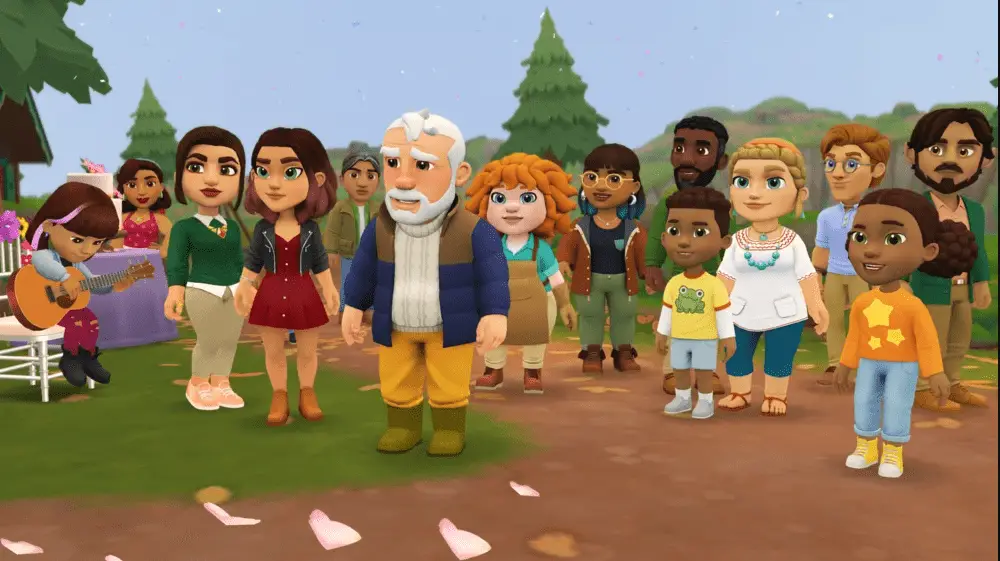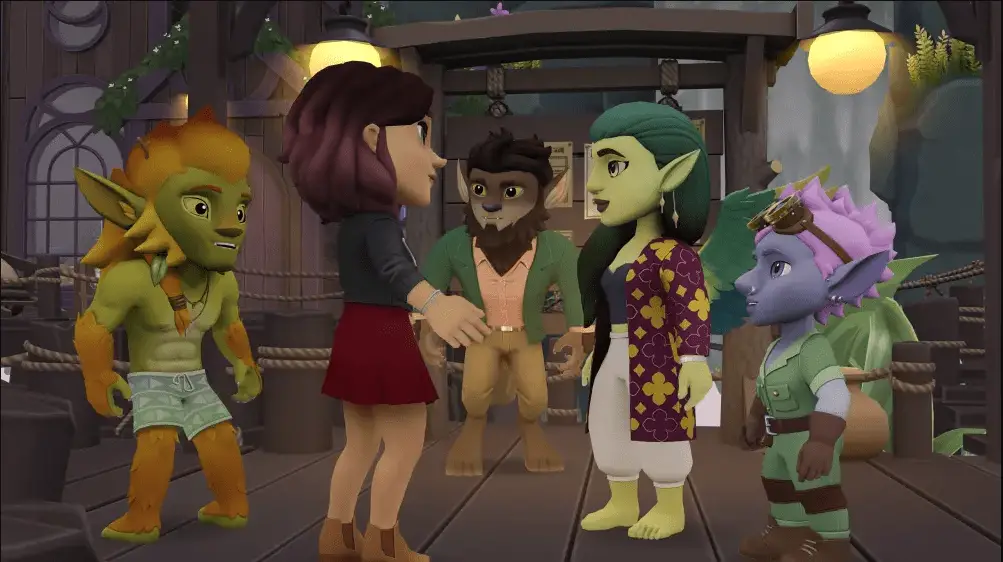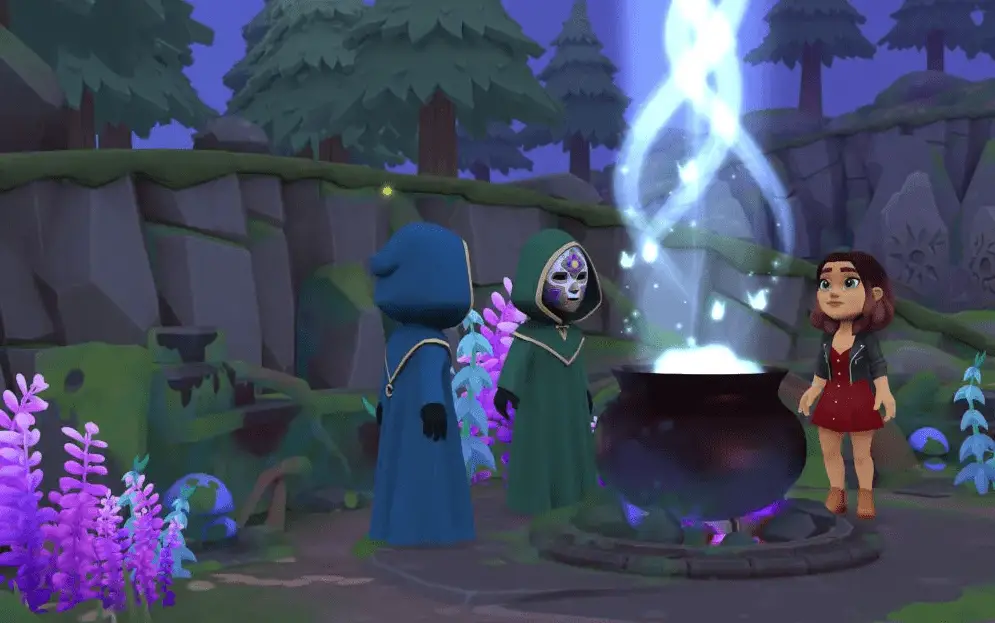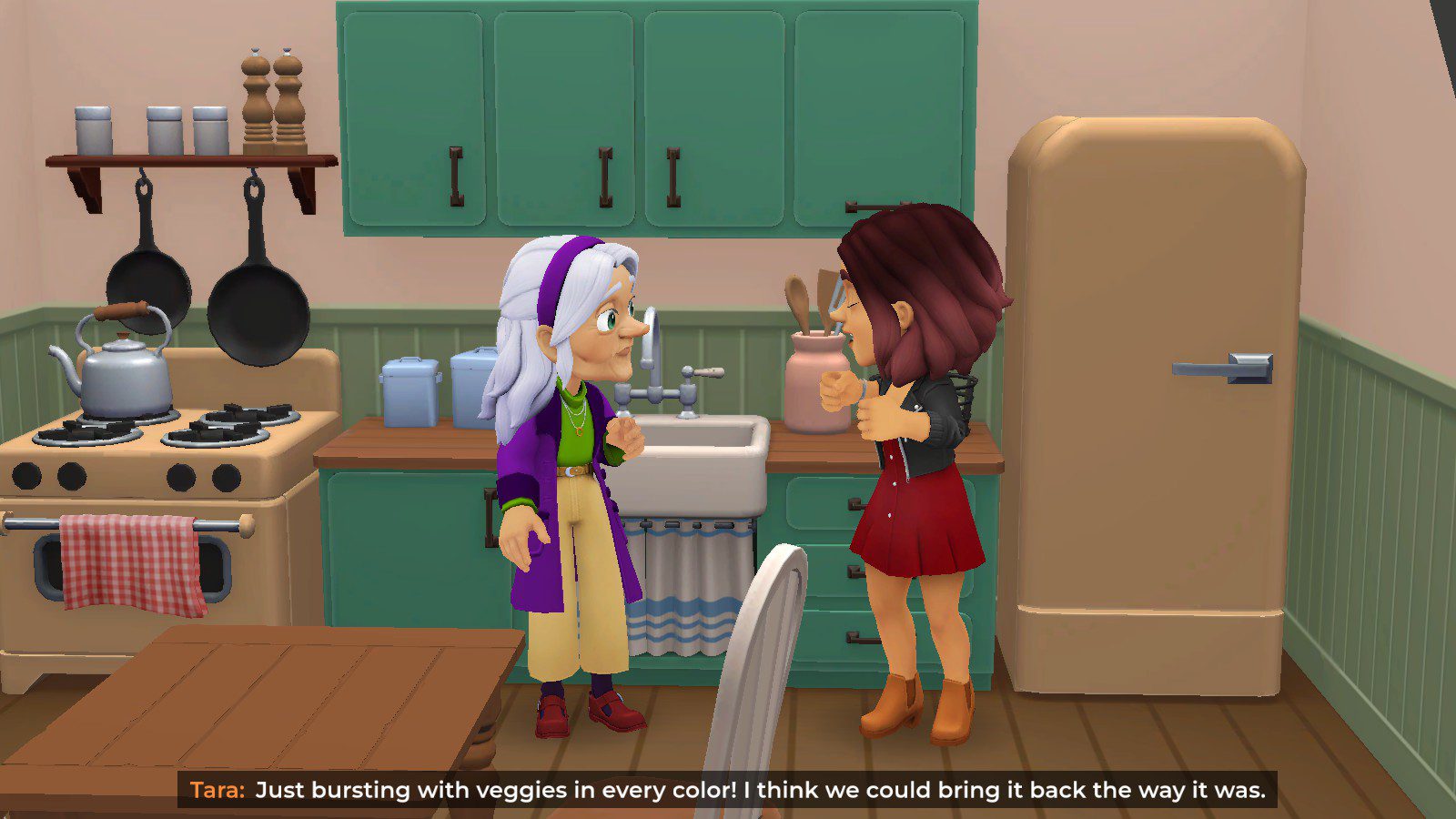From Melbourne developer Studio Drydock, Wylde Flowers is an immersive cozy farming game where the main character Tara has returned to her grandmother’s home, Fairhaven, a multi-cultural seaside town. Oh, and she’s a witch! Part Hallmark return to one’s roots and part Lifetime-style mystery, the main game takes place over the course of a year and challenges Tara to decide what’s right for her in a heartfelt story about community and found family.
Tara has returned to Fairhaven in the spring after the quintessential break-up and getting fired expected in stories like this. Setting out to help and take care of her grandma Hazel, Tara works to fulfill quests from characters and create a new life for herself.
The player has choices about who they focus on befriending or romancing since the only way to move relationships forward is to talk to each person over and over again. You can also gift them one of their favorite dishes for a boost, but I mostly focused on talking to them endlessly especially since the entire game is voice-acted! It’s incredible, and even when the game runs out of dialogue (depending on where you are in a quest and a season), it isn’t a bother to hear the same dialogue a few times.

Having such a diverse cast is also an absolute joy, and I loved hearing characters say words in different languages since we’ve got characters from all over the world. The cast is also incredibly queer, with Tara herself being able to romance people of multiple genders. Depending on who the player chooses to romance (if at all), the game ends with multiple queer couples, and one wedding that the narrative requires Tara to help with! There are also a number of reveals around past exes and connections to characters still in town and gone.
One of my favorite characters is Hazel’s farm neighbor, Thomas Lightfoot, an Indigenous man who regularly talks to Tara about being a good steward of the land, which I absolutely love and want to see more of in all these farming/building games, forever, the end. The kid characters are also super realistic and hilarious.
Unfortunately, there are no physically disabled characters, and the island’s design itself is not accessible. Even if, say, the game was going to add more characters (there are plans to add more quests and things for players to do in year 3), the island’s design would require ramps and adjustment for a wheelchair-using character. I am hopeful that Studio Drydock will take this into account for whatever they’re currently plotting!
Outside of the quests, you can focus on crafting clothing — because one of the characters is a designer — or garden, farm, fish, and work to find everyone’s favorite dishes endlessly. The soundtrack is responsive and absolutely gorgeous. There were a few times where I just sat listening to the song playing instead of moving around the island, and the art design is quite lifelike with animator Mike Taylor giving every character their own walk cycle!
I couldn’t help but think of the term ‘wholesome games’ while playing. Originally oriented towards showcasing indie games that are “hopeful video games with rich storytelling, innovative gameplay, and beautiful art and sound,” the Wholesome Games Direct first premiered in 2020. The debate around the usage of the term was intense. Is it about an aesthetic? The gameplay? The stories? Does it pigeonhole a certain type of game?
Does it (now in year 3) force developers to create games to fit the general ~vibes? Obviously, it will depend on the designer and gamer how they feel about the labels, but per Matthew Taylor, whom I interviewed in 2021, wholesome is “uplifting, thoughtful, compassionate, and cozy.”
The debate around cozy [genre] is nothing new, and especially not in the last few years as we all looked towards something hopeful during a global pandemic, but the issue with cozy as a label is that it oftentimes masks violence and prejudice or completely disregards the genre it’s describing in the first place.

What does it say about cozy, witchy, romcom books that they have plot points where a witch puts a curse on her daughter’s soulmate, so that they can’t sleep with anyone but the daughter? What kind of JustNoMIL Reddit post is that? Or that entire towns are getting memory-wiped so they can’t ever remember they saw magic? Or that the folks without magic are constantly mistrusted and assumed to be out to get the witches? Or the ahistorical “all the witches were burned in our history” when no, that did not happen in the US (it did in Europe). Or that they’re overall…super white…and racist…
Elsewhere, if you spend any time online, you probably saw the fracas over cozy horror thanks to an article from The Mary Sue that talked about horror being an endurance sport associated with masculinity and how cozy horror was feminine. Anyone can say what they want on the internet, but they should expect an uproar if they say something that wrong. Of course, this led to all sorts of debate over what constitutes cozy horror but if much of what is identified as cozy horror by its proponents removes discomfort from the equation, then that’s not really horror is it? These pieces of media could be labeled any number of other genres.
Similarly, cozy fantasy has taken the book world by storm with (very broadly speaking) low-stakes, low-stress, small-town/locations with a pick of the favorite beings we look for in fantasy like elves and orcs or whichever. Yet one of the books that I’ve seen recommended the most doesn’t seem to care at all about anything but the main character doing what she wants with no regard for others being harmed by another character’s protection racket for business. She got hers so who cares about the rest, right?
None of this is to say that something labeled as cozy is immediately an issue but what is so often found in cozy “insert genre” is a lack of true connection to the genre it’s supposedly describing or just white supremacy in disguise. Wylde Flowers takes its narrative and genre(s) seriously, making it an almost perfect cozy paranormal witchy mystery horror romance all at once.
(Story spoilers below, but no identification of the characters.)

Tara must rebuild Hazel’s farm, but she must also investigate why the Wellspring is having issues. It’s losing its power and at one point someone blasts through the bramble gate that keeps the coven area off-limits from the others. Too bad she can’t ask anyone outright since no one but the coven members know that there are witches!
Not all the coven members want to keep it a secret, however. Hazel doesn’t even wear her mask and cloak but the others are super worried about what might happen. Considering the island is all of 24 people including Tara and then the four fae… It’s not like there’s really anywhere to run away to if people react poorly.

Worse, throughout the process of investigating, Tara and other coven members enter the Gloaming, a magical realm where the heart of the Wellspring rests and find out that one of the coven member’s missing mother had left behind messages four years ago when she went missing! Of course that coven member is distraught and the others feel guilty about not looking for her more, and that’s just one example of the difficult things going on for Tara and her new friends and family.
One character’s husband passed away, so their daughter is understandably going through it, and we learn later in the game that he had been one of the coven members. That means prior to Tara arriving, the coven had lost three different members including the High Priestess’ father, who is now residing in a different city where he can get long-term care.
Turns out that there are wraiths (which Amira, the Persian character, calls Jinns in an interesting use of the figure) that had been locked away in the Gloaming. They get out and possess three different characters who then accuse others of being Malcontents, which is what one of the characters who runs the “Consciousness Center” calls problematic people. (It’s kind of culty and has a number of community members, which adds more friction between couples and family members.) Hilariously, this character is a romanceable, and I bet that wedding has snarky responses from others.
This plot is what makes Wylde Flowers so dang compelling and immersive. Don’t get me wrong, I would have enjoyed just farming and exploring life as a witch but it’s much more interesting and entertaining to go along with Tara to solve the mystery.

Of course, the wraith(s) don’t possess random people. We learn as Tara continues to investigate and craft spells to expel the wraiths, that the people who have been so quick to call others malcontents have their own backstories with witches, further humanizing the whole group.
But, there’s nothing cozy about lying to your spouse since the moment you met, or hiding who you are from your kids until they reach a certain age. What could be more horrifying than that? There’s also nothing cozy about grief, which the game does not shy away from. Between the loss of a beloved community member during the game, the grief of losing parents and spouses, and the everyday grief that we all face as the world changes around us, Wylde Flowers is committed to carving out spaces in its narrative for players to feel and experience trauma recovery as the game progresses into Winter.
The team’s writing of why coven members are so afraid of telling the truth and why the nonwitches are so quick to suspect other members of the community is nuanced and real. So real that you’ll want to shake some of the characters, and whether they’re redeemed is dependent entirely on your own experiences and perspectives.
By focusing on Fairhaven (and the fae’s) interactions with each other, the experience of finding out all the secrets and moving forward is made cozy by the game’s music, art, and design without shying away from difficult topics, taking Wylde Flowers from another cozy farming game to a piece of media with a strong personality and story to tell.
I can’t wait to see what the studio has coming next and for another game where I can play for 60 hours and not get bored!
You can get the game on Apple Arcade, Nintendo Switch, and Steam now.
Images and review copy courtesy of Studio Drydock
Have strong thoughts about this piece you need to share? Or maybe there’s something else on your mind you’re wanting to talk about with fellow Fandomentals? Head on over to our Community server to join in the conversation!

